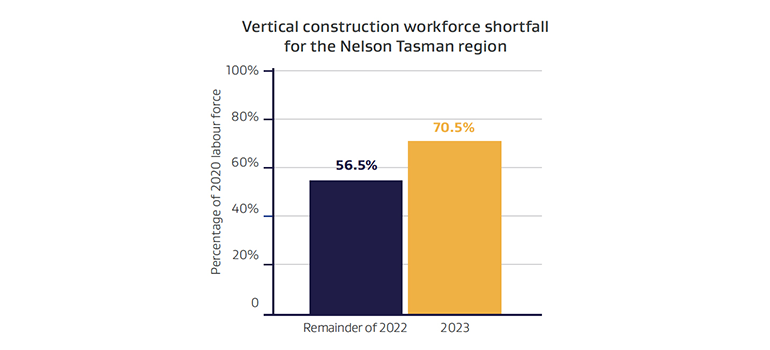Construction industry – addressing workforce issues in Nelson Tasman
Construction is both a significant employer in the Nelson Tasman economy, and a significant contributor to it. In 2019 it was the fourth-largest contributor to our region’s GDP at $401 million (Infometrics – Structure of Nelson-Tasman’s Economy 2021) and provided 8.8% of filled jobs (Infometrics – Filled jobs by ANZSIC level 1 industry, 2021). We also know that many people in our regional construction industry are self-employed.
On this page
However, there is a significant gap between our current regional construction workforce, and the supply required to match current and future levels of construction demand, as set out in the Nelson Tasman Future Development Strategy 2022-2052 (a joint project by the Nelson City and Tasman District Councils).
Nelson Tasman future development strategy 2022-2052(external link) — Nelsontasman.govt.nz
We need the sector to keep growing to meet our region’s demands
The Nelson Tasman region has increased in population and housing construction, and the Future Development strategy predicts we may need to find space for between 2,000 and 12,000 extra homes across Nelson and Tasman over the next 30 years, in addition to space for industry. The demand for housing (for both buying and renting) is not meeting current supply. This housing demand, combined with regionally low wages, results in a significant challenge in attracting and retaining construction workers.
We may need to find space for between 2,000 and 12,000 extra homes across Nelson and Tasman over the next 30 years, in addition to space for industry.
In addition to housing, we also have significant construction projects planned, including the Nelson Hospital rebuild, building the Science and Technology and Riverside precincts in Nelson, the $28m redevelopment project to build 20 homes in Motueka at the Te Āwhina Marae, and the Te Āwhina Marae Trades Training and Technology Hub.
For the sector to keep growing, we need a workforce that is large and skilled enough to meet the demands of residential, commercial, and public construction. This includes both vertical construction (above ground) and horizontal construction (roading and other infrastructure). Current data on the supply of our construction workforce in relation to demand is captured on the Workforce Information Platform (WIP), managed by Waihanga Ara Rau (the Construction and Infrastructure WDC). This forecasts regional vertical construction, with the intention to add horizontal construction workforce information by the end of June 2022. This will be a key tool in construction workforce planning for our region.
To learn more about the challenges and opportunities the sector faces, the Nelson Tasman RSLG hosted four workshops with the Building and Construction Industry Training Organisation (BCITO), Skills Org, Competenz, and Connexis. About 30 people attended each workshop, with local representatives from all parts of the sector. Participants were tasked with identifying barriers, potential solutions and priorities, leading to regional recommendations. The full report of these Nelson Tasman workshops is now available, along with more data on Nelson Tasman Construction Workforce Planning and Development.
After holding 11 workshops in different regions, a review found that the issues we face regionally are common throughout New Zealand.
Over time, 3 key solutions emerged:
- Increase the workforce.
- Do more with the workforce we have.
- Postpone or cancel projects to reduce demand.
Challenges and opportunities
Nationally, the construction sector is looking at these three ways to alleviate the national workforce supply and demand issues. It will be using the goals of the Construction Capability Plan on addressing supply by optimising workforce capability.
Construction accord transformation plan [PDF 4.6MB](external link)
To avoid the ‘boom and bust’ workforce cycle that has led to capability loss in the workforce, the sector is also looking to support the industry to base workforce planning on longer-term trends.
COVID-19 responses such as Apprentice Boost and the Targeted Training and Apprenticeship Fund (TTAF) have reduced this cycle since 2020, but we still have significant workforce shortages – which result in housing shortages. Budget 2022 has extended funding for these apprenticeship initiatives, ensuring we can continue to encourage and support construction apprenticeships.
Consented projects together with an allowance for unconsented work (estimated at $1B per quarter nationally) highlights a gap between our current construction workforce and the supply required to match the current levels of demand. We are short now and based on forecast demand will be in crisis if we don’t start creating a skills pipeline now to develop our construction workforce.
The vertical construction workforce shortfall for the Nelson Tasman region is estimated to be almost 3,200 workers for the remainder of 2022 (56.5% of 2020 labour force). For 2023 the shortfall average is over 3,950 (70.5% of 2020 labour force), without factoring in the effect of delayed projects due to workforce shortages or supply channel issues in 2022.

Text description of graph
Demand for construction workers is already outstripping supply, and Nelson Tasman needs to attract skilled labour and also train more people in all aspects of construction. We need to enable both school-leavers and career changers to access apprenticeships. We also need to address negative perceptions of the industry and ensure people know about the wide variety of career pathways in the construction and infrastructure workforce. In addition, the length of time it takes to complete training can be a barrier to people joining the industry.
Waihanga Ara Rau WDC will continue its work to increase diversity, including increasing the numbers of women, who currently make up only 2.2% of the national construction industry workforce. Increasing support for self-employed construction workers has also been highlighted to assist with retention.
Another challenge is the lack of mid-level qualifications, or micro-qualifications for specific skills, that could assist with further developing skill levels. The construction industry has also acknowledged that it does not have enough supervisors to support the number of trainees.
We also need to support new workers as they enter the industry, acknowledging the need to assist with being ‘work-ready’ for the industry, including transport to jobs, especially if they don’t have a driver licence. Businesses need to make sure their cultures meet new workers’ needs – for example, by acknowledging that apprentices need to do paperwork, and support to undergo driver licensing training and testing.

Regional actions we will take in Nelson Tasman
Regional participants developed actions during a series of Nelson Tasman workshops with the construction sector in 2021. The full Waihanga Ara Rau Nelson Tasman construction sector report from the workshops is available below. We will work with Waihanga Ara Rau WDC and industry to establish working groups to develop an implementation plan for these actions:
- Support and increase trades promotion in schools – collaborating to increase direct links with local industry and training providers, including the Top of the South Trades Academy. Also working with Waihanga Ara Rau’s Vocational Pathways Advisor to improve access to high-quality careers information, advice, and guidance.
- Support further research with local youth and their whānau – to identify their needs and develop ideas to increase engagement in regional construction industry training. Attract women and other under-represented groups into the construction workforce – working with Waihanga Ara Rau’s team on ‘Growing and Strengthening the Workforce through Diversity’, including developing and delivering appropriate incentives and services within the industry.
- Investigate opportunities to provide more allied trades training in our region – working with the regional representative for Waihanga Ara Rau WDC. One way to do this is to establish a working group including Chairs of allied trades, industry employers, iwi, NMIT, ITO, and representatives from all colleges.
- Work with NRDA to promote long-term opportunities in construction and infrastructure – including identifying and delivering ways to target ‘career changers’ to move permanently to the Nelson Tasman region.
- Be advocates for developing skills pipelines that support significant capital projects – supporting work underway to develop the regional construction workforce to deliver projects over the next 10 years, including:
- Nelson Hospital rebuild
- Te Awhina Marae project
- Nelson Library redevelopment and Riverside precinct
- science and technology precinct.
- Support pathways to deliver construction related trades training and better employment outcomes in the construction sector for Māori – including supporting iwi/Māori-led development projects such as the Te Awhina Marae Trades Training and Technology Hub
Our recommendations for national consideration
We strongly recommend the Tertiary Education Commission (TEC):
- funds the Waihanga Ara Rau WDC to maintain and develop the WIP, including adding forecast infrastructure/horizontal construction projects to this database. The WIP will enable forecasting data to guide planning for our region’s industry workforce
- works with the Ministry of Education to improve rangatahi access to driver training, testing, and obtaining their driver licence. This includes making funding available for learners to earn up to eight NCEA credits at NZQF level 1 and 2.
Central Government - We also recommend central government considers the funding and establishment of a construction skills hub, to support both the Nelson Hospital rebuild and the wider cluster of capital projects within the Nelson Tasman region.

